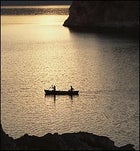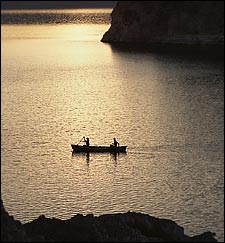To his 14-year-old son, Max, he’s Papa. But in the world of exploration, Børge Ousland is Hercules on skis. The Norwegian’s feats are nothing less than monumental: He was the first person to ski solo to the North Pole (1994), the first to ski solo across Antarctica (1997), and the first to ski solo across the frozen Arctic Ocean (from Siberia to Canada, in 2001). But last summer Ousland swapped his 375-pound sled for a collapsible canoe and the frozen ice pack for the frigid waters of the Karasjokka River in northern Norway. Excerpts from his journal reveal that the nine-day, 62-mile canoe trip down the Class I-II Karasjokka with Max, and guide and friend Stig-Tore Johansen, was his most memorable adventure yet.

Monday, July 29
Miles paddled: 0
No Man’s Land
“Aren’t there any trees here?”
Max glances down at the tundra-like landscape with dismay as our flight lands at Alta, the main town in far northern Finnmark County. Stig-Tore, who traveled 280 miles from his home in Kirkenes, a Norwegian mining town sandwiched between Russia and the Barents Sea, meets us. Together we drive from Alta two hours southeast to a village on the Finnish border, Karasjok. Here the indigenous Sami people have survived by herding reindeer for more than a thousand years. We find the mouth of the Karasjokka River, where we leave the car.
Our plan is to charter a four-seat Cessna seaplane south from Karasjok to the headwaters of the Karasjokka in the Øvre Anarjokka National Park, then canoe our way back downstream. When we arrive at the Karasjok runway to catch our seaplane, Max spots an elderly man in rubber boots and an open shirt walking slowly toward us. “Is that the pilot?” Max whispers apprehensively in my ear. But Max need not worry—Ole Julius Eriksen has been a local bush pilot since 1964. By the time we’ve finished loading the plane, paddles are sticking out between our heads in the small space.
Spanning more than 12 million acres, Finnmark is Norway’s largest county and a sort of Scandinavian Alaska with its stark coastal landscape and verdant river valleys. I am hoping this trip will instill a love of the outdoors in Max—he needs something exciting enough to sow the seeds now, before girls and other interests take over completely.
After flying south for half an hour, Eriksen lands the plane on a little lake by the side of the Karasjokka River as gently as a mother putting down her baby. It’s 9 p.m. and still light, so we have absolutely no desire to go to bed. We carry our canoe and backpacks down to the river and set up camp. I notice that there are hardly any mosquitoes this year. A summer’s evening this far north can be chilly; soon we’re sitting around the campfire staring into the flames. Max and I had been camping not so long ago—in May, in the woods outside Oslo. It’s good to be camping together again.
Tuesday, July 30
Miles paddled: 4
Checkmate
Breakfast consists of porridge and a game of chess. I retain the upper hand until, suddenly, I lose my queen. “Checkmate,” says Max, smiling. He’s rather surprised his surroundings have vegetation—grasses and birches—and don’t resemble Mordor, the wasteland of rocks in The Lord of the Rings, considering that we’re more than 200 miles north of the Arctic Circle. I think he’s already starting to like this place.
Within half an hour, the three of us have assembled the collapsible canoe (made of aluminum with a rubber-coated canvas exterior) and loaded our gear. Max is concerned about the white foam forming over the great stones in the river, so we nose carefully forward. The Karasjokka is principally a kayaking river, and our canoe feels vulnerable in the Class II rapids. At the Suorbmu tributary, we are forced to carry it. This is one of the few spots where the water becomes a Class V foaming inferno, and we can barely hear one another speak. The wreck of an old canoe lies shattered among the rocks, telling its own indisputable tale.
By day’s end, we manage to paddle only four miles, but things have gone well. Max has landed a 13-pound pike. Checkmate again. Below the rapids we find a superb camping spot—a stony point with a flat, grassy space for the tent. We haven’t taken a stove and will cook over the fire. And though we packed rice, corn, and onions, we haven’t brought enough for the entire trip. The idea is to make use of nature’s bounty and leave a little to providence.
Wednesday, July 31
Miles paddled: 6.5
Hullfossen
(Hole Falls)
I get up early. While the others are still asleep I sit looking at the river flowing past. Morning is the best time of the day, when everything wakes into life and the mist rises before the sun. After a while Max crawls out of the tent and sits next to me, swaddled in his sleeping bag. We sit still and don’t talk, and yet we are perfectly happy.
Things are a good deal more exciting today. The river is faster, pressing and tugging at the canoe. Suddenly we hit a rock, broadside, and our canoe is on the verge of going under. We all have to get out into 45-degree water to push, and get soaked while doing it. We are only half-prepared for something like this. Max sees our lack of control and grows fearful, reacting in silence to my sharp commands. When it’s all over, we high-five one another for a job well done.
A mile and a half downriver from our soaking, we portage the Hullfossen, Class V rapids that cut through narrow, 200-foot-tall rock walls. We pitch camp on a little island nearby, where we can hear the roar of the waterfall echoing through the canyon. Evening brings damp, cold air, and mist rises from the water. We dry our clothes and boots and keep the coldat bay with a fire. We patch a minor puncture in the canoe with fabric and glue. Time to dream, tell stories. What does Max want to be when he grows up? A designer, he says. Or maybe a filmmaker. It’s nice to sit and let the words flow, just as people have always done around the fire.
Friday, August 2
Miles paddled: 7
Rain and Gray
We awake to rain. The wind, coming now from the north, is colder; we warm ourselves up by the campfire before pushing off down the charcoal-gray river. The scenery has grown wilder, more beautiful. The birch forest gradually peters out as we descend, making way for forests of larger, more sheltering pine. We see eagles, falcons, and ducks. The riverbank is pockmarked with reindeer tracks—they have presumably been down to drink during the night. The rain eases and the sky clears.
Max is adapting amazingly well. We pick mushrooms and berries for dinner, and he goes fishing with the rod I chose for him after my crossing of Antarctica in 1997. It was in Antarctica where I dreamed about Max and me in a green world—where everything was alive.
Sunday, August 4
Miles paddled: 6.5
Storfossen
(Big Falls)
Storfossen is a two-mile-long ferment of whitewater, with a dozen small drops, that is possible to paddle in kayaks only if you are good. We paddle rapidly to the bank once we hear Storfossen’s deep rumble and see the line of troubled water across the river a little ways ahead. Stig-Tore and I walk down to take stock of the rapids, while Max, inspired by Hullfossen and Mordor, remains behind to draw a map of the area. We decide we have to carry the canoe around the whitewater.
That evening we have a feast. Max lands a small salmon, and for dessert we stew freshly picked bilberries with sugar. Everyone gets stained blue.
The next morning I’m up early to try casting above the rapids. There’s a sudden jerk on my line and a swirl of water. I shout for the others. Max comes running in nothing but his underpants and gapes as the salmon jumps and reveals its size. After 40 nail-biting minutes I manage to land it. On our improvised scale it measures 29 pounds: a record for me. We salt the fillets to take home.
Tuesday, August 6
Miles paddled: 7
Final Approach
The Karasjokka is now wide and shallow enough for us to run aground. Huts start appearing on the banks. Talk turns to Max and school. He will be starting Norway’s equivalent of high school in a couple of years and is curious about attending the one in Kirkenes where Stig-Tore teaches economics. Stig-Tore offers to let Max live in the basement of his flat. It’s an idea that doesn’t strike Max as all that bad.
When we see the main road swing in to run close to the river, we know our adventure has come to an end. We haul the canoe up onto the bank, and while I pack up our gear, Stig-Tore and Max thumb a lift down to the car. Once we’re traveling toward Alta, Max is on the mobile to his mother. “The trip was great, Mom,” Max says. “I’m thinking of moving up here. I’m going to go to high school in Kirkenes—that’s OK, isn’t it?” Stig-Tore and I smile at each other: I couldn’t have dared hope for better proof of a successful trip.


